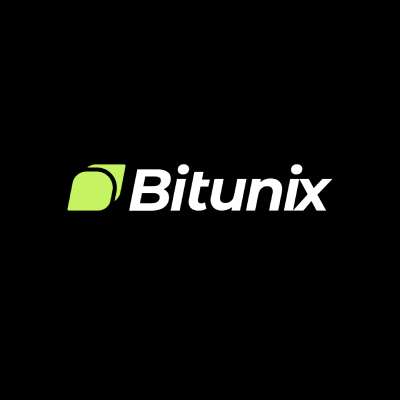คำอธิบายโดยละเอียดของโครงการ io.net ล่าสุดของ Binance Launchpool: การเชื่อมต่อทรัพยากร GPU ทั่วโลกเพื่อปรับเปลี่ยนอนาคต
ที่มา : ร้านชาเครือเชน
1. การแนะนำโครงการ
io.net เป็นระบบ GPU แบบกระจายที่ใช้พื้นฐานจาก Solana, Render, Ray และ Filecoin ออกแบบมาเพื่อใช้ประโยชน์จากทรัพยากร GPU แบบกระจายในการแก้ปัญหาการประมวลผลในสาขา AI และการเรียนรู้ของเครื่องจักร

io.net แก้ปัญหาทรัพยากรคอมพิวเตอร์ที่ไม่เพียงพอด้วยการรวบรวมทรัพยากรคอมพิวเตอร์ที่ไม่ได้ถูกใช้ประโยชน์อย่างเต็มที่ เช่น ศูนย์ประมวลผลข้อมูลอิสระ ผู้ขุดสกุลเงินดิจิทัล และ GPU ส่วนเกินจากโครงการสกุลเงินดิจิทัลเช่น Filecoin และ Render ช่วยให้วิศวกรสามารถรับพลังการประมวลผลจำนวนมากในระบบที่เข้าถึงได้ง่าย ปรับแต่งได้ และมีต้นทุนต่ำ
นอกจากนี้ io.net ยังเปิดตัวเครือข่ายโครงสร้างพื้นฐานทางกายภาพแบบกระจาย (depin) โดยผสมผสานทรัพยากรจากผู้ให้บริการที่หลากหลายเพื่อให้วิศวกรสามารถเข้าถึงพลังการประมวลผลจำนวนมหาศาลได้ในลักษณะที่ปรับแต่งได้ คุ้มต้นทุน และใช้งานง่าย
ปัจจุบัน io cloud มี GPU มากกว่า 95,000 ตัวและ CPU มากกว่า 1,000 ตัว รองรับการปรับใช้ที่รวดเร็ว เลือกใช้ฮาร์ดแวร์ พื้นที่ทางภูมิศาสตร์ และมีกระบวนการชำระเงินที่โปร่งใส
2. กลไกหลัก
2.1 การรวมทรัพยากรแบบรวมศูนย์
การรวมทรัพยากรแบบกระจายอำนาจของ io.net เป็นหนึ่งในฟีเจอร์หลัก ซึ่งช่วยให้แพลตฟอร์มสามารถใช้ทรัพยากร GPU แบบกระจายอำนาจทั่วโลกเพื่อให้การสนับสนุนการประมวลผลที่จำเป็นสำหรับงาน AI และการเรียนรู้ของเครื่อง เป้าหมายของกลยุทธ์การรวมทรัพยากรนี้คือเพื่อปรับการใช้ทรัพยากรให้เหมาะสม ลดต้นทุน และให้การเข้าถึงที่กว้างขึ้น
ต่อไปนี้เป็นคำอธิบายโดยละเอียด:
2.1.1 ข้อดี
ความคุ้มทุน: ด้วยการใช้ประโยชน์จากทรัพยากร GPU ที่ไม่ได้ใช้งานอย่างเต็มที่ในตลาด io.net จึงสามารถมอบพลังการประมวลผลที่มีต้นทุนต่ำกว่าบริการคลาวด์แบบเดิมได้ ซึ่งสิ่งนี้มีความสำคัญอย่างยิ่งสำหรับแอปพลิเคชัน AI ที่ใช้ข้อมูลจำนวนมาก ซึ่งมักต้องใช้ทรัพยากรการประมวลผลจำนวนมาก ซึ่งอาจมีราคาแพงในวิธีการแบบเดิม ความสามารถในการปรับขนาดและความยืดหยุ่น: โมเดลแบบกระจายอำนาจช่วยให้ io.net สามารถขยายกลุ่มทรัพยากรได้อย่างง่ายดายโดยไม่ต้องพึ่งพาผู้จำหน่ายหรือศูนย์ข้อมูลรายเดียว โมเดลนี้ช่วยให้ผู้ใช้มีความยืดหยุ่นในการเลือกทรัพยากรที่เหมาะสมที่สุดกับความต้องการงานของตน
2.1.2 หลักการทำงาน
ความหลากหลายของแหล่งทรัพยากร: io.net รวบรวมทรัพยากร GPU จากหลายแหล่ง รวมถึงศูนย์ข้อมูลอิสระ ผู้ขุดสกุลเงินดิจิทัลรายบุคคล และทรัพยากรส่วนเกินจากโครงการสกุลเงินดิจิทัลอื่นๆ เช่น Filecoin และ Render การใช้งานทางเทคนิค: แพลตฟอร์มใช้เทคโนโลยีบล็อคเชนเพื่อติดตามและจัดการทรัพยากรเหล่านี้ เพื่อให้แน่ใจว่ามีความโปร่งใสและยุติธรรมในการจัดสรรทรัพยากร เทคโนโลยีบล็อคเชนยังช่วยทำให้การชำระเงินและแรงจูงใจเป็นไปโดยอัตโนมัติสำหรับผู้ใช้ที่เพิ่มพลังการประมวลผลเพิ่มเติมให้กับเครือข่าย
2.1.3 ขั้นตอนที่เจาะจง
การค้นหาและลงทะเบียนทรัพยากร: ผู้ให้บริการทรัพยากร (เช่น เจ้าของ GPU) ลงทะเบียนอุปกรณ์ของตนกับแพลตฟอร์ม io.net แพลตฟอร์มจะตรวจสอบประสิทธิภาพและความน่าเชื่อถือของทรัพยากรเหล่านี้เพื่อให้แน่ใจว่าเป็นไปตามมาตรฐานและข้อกำหนดเฉพาะ การรวมทรัพยากร: ทรัพยากรที่ตรวจสอบแล้วจะถูกเพิ่มเข้าในกลุ่มทรัพยากรทั่วโลกและผู้ใช้แพลตฟอร์มสามารถเช่าได้ การแจกจ่ายและการจัดการทรัพยากรจะดำเนินการโดยอัตโนมัติผ่านสัญญาอัจฉริยะ ซึ่งรับประกันความโปร่งใสและประสิทธิภาพของกระบวนการ การจัดสรรทรัพยากรแบบไดนามิก: เมื่อผู้ใช้เริ่มงานการประมวลผล แพลตฟอร์มจะจัดสรรทรัพยากรแบบไดนามิกตามข้อกำหนดของงาน (เช่น พลังการประมวลผล หน่วยความจำ แบนด์วิดท์เครือข่าย ฯลฯ) การจัดสรรทรัพยากรจะคำนึงถึงประสิทธิภาพด้านต้นทุนและตำแหน่งทางภูมิศาสตร์ โดยเพิ่มประสิทธิภาพความเร็วและต้นทุนในการดำเนินการงาน
2.2 ระบบเศรษฐกิจโทเค็นคู่
ระบบเศรษฐกิจแบบโทเค็นคู่ของ io.net เป็นหนึ่งในฟีเจอร์หลักของเครือข่ายบล็อคเชน ซึ่งออกแบบมาเพื่อสร้างแรงจูงใจให้กับผู้เข้าร่วมเครือข่ายและรับรองประสิทธิภาพและความยั่งยืนของการดำเนินงานของแพลตฟอร์ม ระบบนี้ประกอบด้วยโทเค็น 2 ตัว ได้แก่ $IO และ $IOSD ซึ่งแต่ละตัวมีบทบาทเฉพาะตัว ต่อไปนี้คือคำอธิบายโดยละเอียดเกี่ยวกับโครงสร้างและฟังก์ชันของระบบเศรษฐกิจนี้
2.2.1 โทเค็น $IO
$IO เป็นโทเค็นยูทิลิตี้หลักของแพลตฟอร์ม io.net และใช้สำหรับธุรกรรมและการดำเนินการเครือข่ายที่หลากหลาย การใช้งานหลักๆ ได้แก่:
การชำระเงินและค่าธรรมเนียม: ผู้ใช้ใช้ $IO เพื่อจ่ายค่าเช่าทรัพยากรคอมพิวเตอร์ รวมถึงการใช้ GPU นอกจากนี้ $IO ยังใช้เพื่อชำระค่าบริการและค่าธรรมเนียมต่างๆ บนเครือข่ายอีกด้วย แรงจูงใจด้านทรัพยากร: โทเค็น $IO จะมอบให้เป็นรางวัลแก่ผู้ใช้ที่ให้พลังการประมวลผล GPU หรือมีส่วนร่วมในการบำรุงรักษาเครือข่ายเพื่อกระตุ้นให้พวกเขาสนับสนุนทรัพยากรต่อไป การกำกับดูแล: ผู้ถือโทเค็น $IO สามารถมีส่วนร่วมในการตัดสินใจด้านการกำกับดูแลของแพลตฟอร์ม io.net รวมถึงสิทธิ์ในการลงคะแนนเสียง และมีอิทธิพลต่อทิศทางการพัฒนาในอนาคตและการปรับเปลี่ยนนโยบายของแพลตฟอร์ม
2.2.2 โทเค็น $IOSD
$IOSD เป็นสกุลเงินดิจิทัลที่ผูกกับดอลลาร์สหรัฐฯ โดยออกแบบมาเพื่อให้แพลตฟอร์ม io.net สามารถจัดเก็บมูลค่าและใช้เป็นสื่อกลางในการทำธุรกรรมได้อย่างมีเสถียรภาพ โดยฟังก์ชันหลักๆ มีดังนี้:
มูลค่าที่มั่นคง: $IOSD ผูกกับดอลลาร์สหรัฐฯ ในอัตราส่วน 1:1 ช่วยให้ผู้ใช้มีวิธีการชำระเงินที่หลีกเลี่ยงความผันผวนในตลาดสกุลเงินดิจิทัล ธุรกรรมที่ง่ายดาย: ผู้ใช้สามารถใช้ $IOSD เพื่อชำระค่าธรรมเนียมแพลตฟอร์ม เช่น ค่าธรรมเนียมทรัพยากรคอมพิวเตอร์ ช่วยให้มั่นใจถึงเสถียรภาพและความสามารถในการคาดเดามูลค่าของธุรกรรม ความคุ้มครองค่าธรรมเนียม: สามารถชำระการดำเนินการเครือข่ายบางส่วนหรือค่าธรรมเนียมธุรกรรมด้วย $IOSD ทำให้กระบวนการชำระค่าธรรมเนียมง่ายขึ้น
2.2.3 ระบบโทเค็นคู่ทำงานอย่างไร
ระบบโทเค็นคู่ของ io.net โต้ตอบกันหลายวิธีเพื่อสนับสนุนการทำงานและการเติบโตของเครือข่าย:
แรงจูงใจสำหรับผู้ให้บริการทรัพยากร: ผู้ให้บริการทรัพยากร (เช่น เจ้าของ GPU) จะได้รับโทเค็น $IO เพื่อแลกกับการมีส่วนสนับสนุนอุปกรณ์ของตนในเครือข่าย โทเค็นเหล่านี้สามารถใช้เพื่อซื้อทรัพยากรคอมพิวเตอร์เพิ่มเติมหรือซื้อขายในตลาดได้ การชำระค่าธรรมเนียม: ผู้ใช้ชำระเงินสำหรับการใช้ทรัพยากรคอมพิวเตอร์ด้วย $IO หรือ $IOSD การเลือก $IOSD สามารถหลีกเลี่ยงความเสี่ยงที่เกิดจากความผันผวนของสกุลเงินดิจิทัลได้ แรงจูงใจสำหรับกิจกรรมทางเศรษฐกิจ: ผ่านการหมุนเวียนและการใช้ $IO และ $IOSD แพลตฟอร์ม io.net สามารถกระตุ้นกิจกรรมทางเศรษฐกิจและเพิ่มสภาพคล่องและการมีส่วนร่วมของเครือข่ายได้ การมีส่วนร่วมในการกำกับดูแล: โทเค็น $IO ยังทำหน้าที่เป็นโทเค็นการกำกับดูแล ช่วยให้ผู้ถือครองสามารถมีส่วนร่วมในกระบวนการกำกับดูแลของแพลตฟอร์ม เช่น ข้อเสนอและการตัดสินใจลงคะแนนเสียง
2.3 การจัดสรรและกำหนดตารางทรัพยากรแบบไดนามิก
การจัดสรรและกำหนดตารางเวลาทรัพยากรแบบไดนามิกของ io.net เป็นหนึ่งในฟังก์ชันหลักของแพลตฟอร์ม สิ่งสำคัญอยู่ที่การจัดการและเพิ่มประสิทธิภาพการใช้ทรัพยากรคอมพิวเตอร์อย่างมีประสิทธิภาพเพื่อตอบสนองความต้องการด้านคอมพิวเตอร์ที่หลากหลายของผู้ใช้ ระบบนี้ช่วยให้มั่นใจได้ว่างานคอมพิวเตอร์สามารถดำเนินการบนทรัพยากรที่เหมาะสมที่สุดได้ในลักษณะที่ชาญฉลาดและอัตโนมัติ พร้อมทั้งเพิ่มการใช้ทรัพยากรและประสิทธิภาพการทำงานสูงสุด
ต่อไปนี้เป็นรายละเอียดด้านต่างๆ ของกลไกนี้:
2.3.1 กลไกการจัดสรรทรัพยากรแบบไดนามิก
1. การระบุและจำแนกทรัพยากร:
เมื่อผู้ให้บริการทรัพยากรเชื่อมต่อ GPU หรือทรัพยากรคอมพิวเตอร์อื่นๆ เข้ากับแพลตฟอร์ม io.net ระบบจะระบุและจัดประเภททรัพยากรเหล่านี้ก่อน ซึ่งรวมถึงการประเมินตัวบ่งชี้ประสิทธิภาพ เช่น ความเร็วในการประมวลผล ความจุหน่วยความจำ แบนด์วิดท์เครือข่าย เป็นต้น จากนั้นทรัพยากรเหล่านี้จะถูกแท็กและเก็บถาวรเพื่อให้สามารถจัดสรรแบบไดนามิกตามความต้องการของงานต่างๆ ได้
2. การจับคู่ความต้องการ:
เมื่อผู้ใช้ส่งงานการประมวลผลไปยัง io.net พวกเขาจะต้องระบุข้อกำหนดของงาน เช่น พลังการประมวลผลที่จำเป็น ขนาดหน่วยความจำ ขีดจำกัดงบประมาณ ฯลฯ ระบบกำหนดตารางการทำงานของแพลตฟอร์มจะวิเคราะห์ข้อกำหนดเหล่านี้และกรองทรัพยากรที่ตรงกันออกจากกลุ่มทรัพยากร
3. อัลกอริธึมการจัดตารางเวลาอัจฉริยะ:
อัลกอริทึมขั้นสูงใช้เพื่อจับคู่ทรัพยากรที่เหมาะสมที่สุดกับงานที่ส่งโดยอัตโนมัติ อัลกอริทึมเหล่านี้จะคำนึงถึงประสิทธิภาพของทรัพยากร ประสิทธิภาพต้นทุน ตำแหน่งทางภูมิศาสตร์ (เพื่อลดเวลาแฝง) และการตั้งค่าเฉพาะผู้ใช้ ระบบกำหนดตารางเวลาจะตรวจสอบสถานะแบบเรียลไทม์ของทรัพยากร เช่น ความพร้อมใช้งานและโหลด เพื่อปรับการจัดสรรทรัพยากรแบบไดนามิก
2.3.2 การกำหนดตารางและการดำเนินการ
1. การจัดการคิวงานและลำดับความสำคัญ:
งานทั้งหมดจะถูกจัดคิวตามลำดับความสำคัญและเวลาในการส่งงาน ระบบจะประมวลผลคิวงานตามกฎลำดับความสำคัญที่ตั้งไว้ล่วงหน้าหรือปรับแบบไดนามิก งานเร่งด่วนหรืองานที่มีความสำคัญสูงจะได้รับการตอบสนองอย่างรวดเร็ว ในขณะที่งานระยะยาวหรืองานที่มีความสำคัญด้านต้นทุนอาจดำเนินการในช่วงเวลาที่มีต้นทุนต่ำ
2. การทนทานต่อความผิดพลาดและการปรับสมดุลโหลด:
ระบบการจัดสรรทรัพยากรแบบไดนามิกประกอบด้วยกลไกที่ทนทานต่อความผิดพลาดเพื่อให้แน่ใจว่าแม้ว่าทรัพยากรบางอย่างจะล้มเหลว งานต่างๆ ก็สามารถโยกย้ายไปยังทรัพยากรอื่นๆ ที่มีความสมบูรณ์เพื่อดำเนินการต่อไปได้อย่างราบรื่น เทคโนโลยีการปรับสมดุลโหลดช่วยให้มั่นใจว่าไม่มีทรัพยากรใดที่โอเวอร์โหลด และเพิ่มประสิทธิภาพการทำงานของเครือข่ายทั้งหมดโดยการกระจายภาระงานอย่างเหมาะสม
3. การติดตามและการปรับปรุง:
ระบบจะตรวจสอบสถานะการดำเนินการของงานทั้งหมดและสถานะการทำงานของทรัพยากรอย่างต่อเนื่อง ซึ่งรวมถึงการวิเคราะห์ตัวบ่งชี้ประสิทธิภาพหลักแบบเรียลไทม์ เช่น ความคืบหน้าของงานและการใช้ทรัพยากร โดยระบบจะปรับการจัดสรรทรัพยากรใหม่โดยอัตโนมัติเพื่อเพิ่มประสิทธิภาพการดำเนินการงานและการใช้ทรัพยากรให้เหมาะสมที่สุด
2.3.3 การโต้ตอบและข้อเสนอแนะของผู้ใช้
อินเทอร์เฟซผู้ใช้ที่โปร่งใส: io.net มอบอินเทอร์เฟซผู้ใช้ที่ใช้งานง่ายซึ่งผู้ใช้สามารถส่งงาน ดูสถานะงาน และปรับความต้องการหรือลำดับความสำคัญได้อย่างง่ายดาย กลไกการตอบรับ: ผู้ใช้สามารถให้คำติชมเกี่ยวกับผลลัพธ์ของการดำเนินการงาน และระบบจะปรับกลยุทธ์การจัดสรรทรัพยากรสำหรับงานในอนาคตตามคำติชมเพื่อตอบสนองความต้องการของผู้ใช้ได้ดียิ่งขึ้น
3. สถาปัตยกรรมระบบ
3.1 คลาวด์ IO
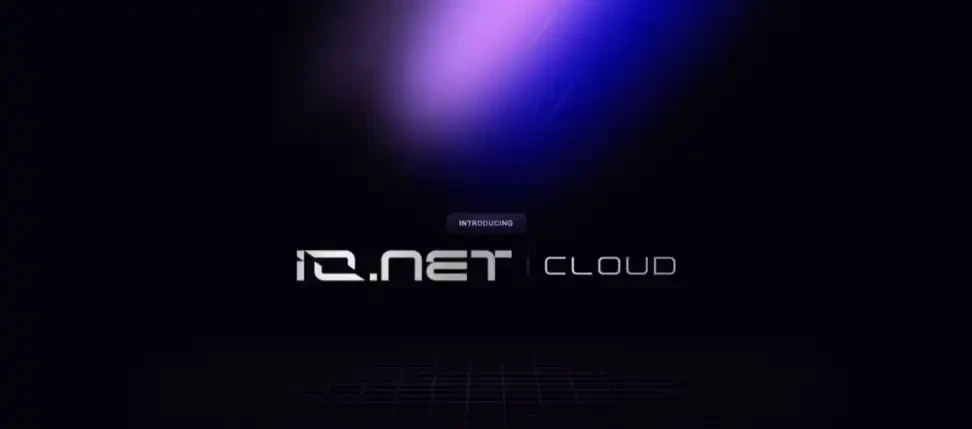
IO Cloud ได้รับการออกแบบมาเพื่อลดความยุ่งยากในการปรับใช้และการจัดการคลัสเตอร์ GPU แบบกระจายอำนาจ โดยให้วิศวกรและนักพัฒนาด้านการเรียนรู้ของเครื่องสามารถเข้าถึงทรัพยากร GPU ที่ปรับขนาดได้และยืดหยุ่นโดยไม่ต้องลงทุนด้านฮาร์ดแวร์จำนวนมาก แพลตฟอร์มนี้มอบประสบการณ์ที่คล้ายกับบริการคลาวด์แบบเดิม แต่มีข้อได้เปรียบของเครือข่ายแบบกระจายอำนาจ
ไฮไลท์:
ความสามารถในการปรับขนาดและราคาที่เอื้อมถึง: ออกแบบมาเพื่อให้เป็นคลาวด์ GPU ที่คุ้มต้นทุนที่สุด ลดต้นทุนโครงการ AI/ML ได้ถึง 90% การบูรณาการกับ IO SDK: เพิ่มประสิทธิภาพโครงการ AI ผ่านการบูรณาการที่ราบรื่น สร้างสภาพแวดล้อมประสิทธิภาพสูงที่เป็นหนึ่งเดียว การครอบคลุมทั่วโลก: ทรัพยากร GPU แบบกระจาย บริการการเรียนรู้ของเครื่องจักรและการอนุมานที่เหมาะสมที่สุด คล้ายกับ CDN การรองรับ RAY Framework: การพัฒนาแอปพลิเคชัน Python ที่ปรับขนาดได้โดยใช้กรอบงานการคำนวณแบบกระจาย RAY คุณสมบัติพิเศษ: ให้การเข้าถึงแบบส่วนตัวไปยังปลั๊กอิน OpenAI ChatGPT เพื่อการปรับใช้งานคลัสเตอร์การฝึกอบรมได้ง่าย นวัตกรรมการขุดคริปโต: มุ่งมั่นที่จะปฏิวัติการขุดคริปโตโดยสนับสนุนระบบนิเวศการเรียนรู้ของเครื่องจักรและปัญญาประดิษฐ์
3.2 คนงาน IO
IO Worker มุ่งหวังที่จะลดความซับซ้อนและเพิ่มประสิทธิภาพการดำเนินการจัดเตรียมสำหรับผู้ใช้ WebApp ซึ่งรวมถึงการจัดการบัญชีผู้ใช้ การตรวจสอบกิจกรรมแบบเรียลไทม์ การติดตามอุณหภูมิและการใช้พลังงาน การสนับสนุนการติดตั้ง การจัดการกระเป๋าเงิน ความปลอดภัย และการวิเคราะห์ผลกำไร
ไฮไลท์:
หน้าแรกของพนักงาน: ให้แดชบอร์ดสำหรับการตรวจสอบอุปกรณ์ที่เชื่อมต่อแบบเรียลไทม์ พร้อมความสามารถในการลบและเปลี่ยนชื่ออุปกรณ์ หน้ารายละเอียดอุปกรณ์: แสดงการวิเคราะห์อุปกรณ์อย่างครอบคลุม รวมถึงปริมาณการใช้งาน สถานะการเชื่อมต่อ และประวัติการทำงาน หน้ารางวัลรายได้: ติดตามรายได้และประวัติการทำงาน พร้อมรายละเอียดธุรกรรมที่เข้าถึงได้บน SOLSCAN หน้าเพิ่มอุปกรณ์ใหม่: ลดความซับซ้อนของกระบวนการเชื่อมต่ออุปกรณ์ ช่วยให้บูรณาการได้รวดเร็วและง่ายดาย
3.3 IO เอ็กซ์พลอเรอร์
IO Explorer ได้รับการออกแบบมาเป็นแพลตฟอร์มที่ครอบคลุมซึ่งมอบข้อมูลเชิงลึกเกี่ยวกับการทำงานของเครือข่าย io.net ให้กับผู้ใช้ ซึ่งคล้ายกับที่ blockchain explorers มอบความโปร่งใสในการทำธุรกรรมของ blockchain เป้าหมายหลักคือเพื่อให้ผู้ใช้สามารถตรวจสอบ วิเคราะห์ และทำความเข้าใจรายละเอียดของ GPU Cloud เพื่อให้แน่ใจว่าสามารถมองเห็นกิจกรรมเครือข่าย สถิติ และธุรกรรมต่างๆ ได้ครบถ้วนในขณะที่ปกป้องความเป็นส่วนตัวของข้อมูลที่ละเอียดอ่อน
ข้อได้เปรียบ:
หน้าแรกของเบราว์เซอร์: ให้ข้อมูลเชิงลึกเกี่ยวกับการจัดเตรียม ผู้จำหน่ายที่ได้รับการยืนยัน จำนวนฮาร์ดแวร์ที่ใช้งานอยู่ และราคาตลาดแบบเรียลไทม์ หน้าคลัสเตอร์: แสดงข้อมูลสาธารณะเกี่ยวกับคลัสเตอร์ที่ติดตั้งในเครือข่าย พร้อมด้วยเมตริกแบบเรียลไทม์และรายละเอียดการจอง หน้าอุปกรณ์: แสดงรายละเอียดสาธารณะของอุปกรณ์ที่เชื่อมต่อกับเครือข่าย โดยให้ข้อมูลแบบเรียลไทม์และการติดตามธุรกรรม การตรวจสอบคลัสเตอร์แบบเรียลไทม์: ให้ข้อมูลเชิงลึกทันทีเกี่ยวกับสถานะคลัสเตอร์ ความสมบูรณ์ และประสิทธิภาพ ช่วยให้ผู้ใช้มีข้อมูลล่าสุด
3.4 IO SDK เวอร์ชัน 3.4
IO-SDK คือเทคโนโลยีพื้นฐานของ Io.net ซึ่งพัฒนามาจากสาขาหนึ่งของเทคโนโลยี Ray เทคโนโลยีนี้ทำให้สามารถทำงานแบบคู่ขนานและประมวลผลภาษาต่างๆ ได้ และยังเข้ากันได้กับกรอบงานการเรียนรู้ของเครื่องจักร (ML) หลักๆ ทำให้ IO.NET มีความยืดหยุ่นและมีประสิทธิภาพสำหรับความต้องการด้านการประมวลผลที่หลากหลาย การตั้งค่านี้ควบคู่ไปกับชุดเทคโนโลยีที่กำหนดไว้อย่างชัดเจน ช่วยให้ IO.NET Portal สามารถตอบสนองความต้องการในปัจจุบันและปรับตัวให้เข้ากับการเปลี่ยนแปลงในอนาคตได้
การประยุกต์ใช้สถาปัตยกรรมหลายชั้น
อินเทอร์เฟซผู้ใช้: ทำหน้าที่เป็นส่วนหน้าสำหรับผู้ใช้ รวมถึงเว็บไซต์สาธารณะ พื้นที่ไคลเอนต์ และพื้นที่ผู้ให้บริการ GPU ออกแบบมาให้ใช้งานง่ายและเป็นมิตรกับผู้ใช้
ชั้นความปลอดภัย: รับประกันความสมบูรณ์และความปลอดภัยของระบบ รวมถึงการป้องกันเครือข่าย การรับรองความถูกต้องของผู้ใช้ และการบันทึกกิจกรรม
ชั้น API: ทำหน้าที่เป็นศูนย์กลางการสื่อสารสำหรับเว็บไซต์ ผู้ให้บริการ และการบริหารภายใน อำนวยความสะดวกในการแลกเปลี่ยนข้อมูลและการดำเนินการ
เลเยอร์แบ็กเอนด์: แกนหลักของระบบ การจัดการการดำเนินการต่างๆ เช่น การจัดการคลัสเตอร์/GPU การโต้ตอบกับไคลเอนต์ และการปรับขนาดอัตโนมัติ
ชั้นฐานข้อมูล: จัดเก็บและจัดการข้อมูล โดยมีพื้นที่เก็บข้อมูลหลักสำหรับข้อมูลที่มีโครงสร้างและแคชสำหรับข้อมูลชั่วคราว
ชั้นงาน: จัดการการสื่อสารและงานที่ไม่พร้อมกัน ช่วยให้มั่นใจว่าการดำเนินการและการไหลของข้อมูลมีประสิทธิภาพ
เลเยอร์โครงสร้างพื้นฐาน: โครงสร้างพื้นฐาน รวมถึงพูล GPU เครื่องมือออร์เคสตรา และงานการดำเนินการ/ML พร้อมด้วยโซลูชันการตรวจสอบที่ทรงพลัง
3.5 อุโมงค์ IO
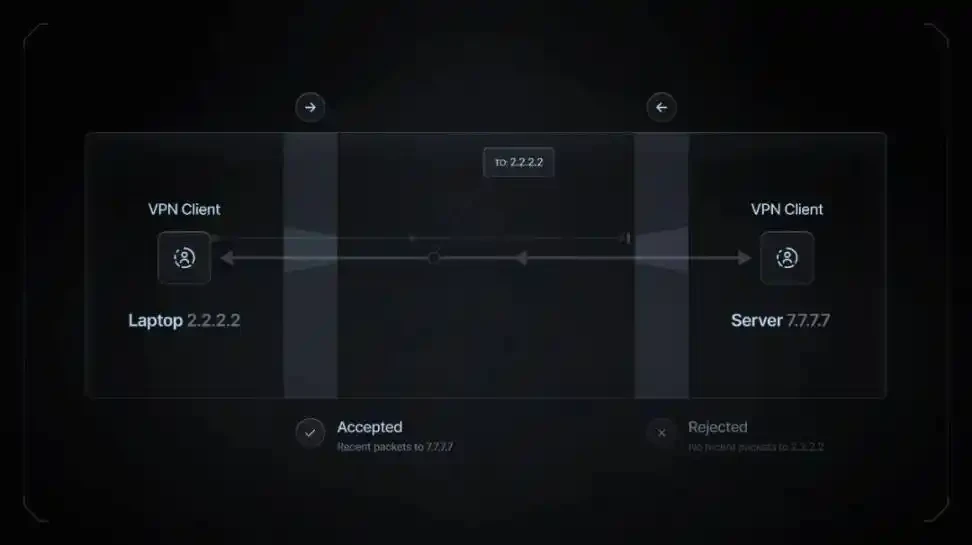
เทคโนโลยีการสร้างอุโมงค์ย้อนกลับใช้เพื่อสร้างการเชื่อมต่อที่ปลอดภัยจากไคลเอนต์ไปยังเซิร์ฟเวอร์ระยะไกล ช่วยให้วิศวกรสามารถข้ามไฟร์วอลล์และ NAT เพื่อการเข้าถึงระยะไกลได้โดยไม่ต้องกำหนดค่าที่ซับซ้อน เวิร์กโฟลว์: IO Worker เชื่อมต่อกับเซิร์ฟเวอร์กลาง (เซิร์ฟเวอร์ io.net) จากนั้นเซิร์ฟเวอร์ io.net จะคอยฟังการเชื่อมต่อจาก IO Worker และเครื่องจักรของวิศวกร ทำให้การแลกเปลี่ยนข้อมูลผ่านการสร้างอุโมงค์ย้อนกลับเป็นไปได้สะดวกยิ่งขึ้น

การประยุกต์ใช้งานใน io.net
วิศวกรเชื่อมต่อกับ IO Workers ผ่านเซิร์ฟเวอร์ io.net ทำให้การเข้าถึงและการจัดการจากระยะไกลง่ายขึ้นโดยไม่ต้องมีปัญหาในการกำหนดค่าเครือข่าย ประโยชน์: เข้าถึงได้ง่าย: เข้าถึง IO Workers ได้โดยตรง ไม่ต้องมีอุปสรรคด้านเครือข่าย ความปลอดภัย: รับรองการสื่อสารที่ปลอดภัยและรักษาความเป็นส่วนตัวของข้อมูล ความสามารถในการปรับขนาดและความยืดหยุ่น: จัดการ IO Workers หลายตัวในสภาพแวดล้อมที่แตกต่างกันได้อย่างมีประสิทธิภาพ
3.6 เครือข่าย IO
เครือข่าย IO ใช้สถาปัตยกรรม VPN แบบเมชเพื่อให้การสื่อสารระหว่างโหนด antMiner มีเวลาแฝงต่ำเป็นพิเศษ
เครือข่าย VPN แบบเมช:
การเชื่อมต่อแบบกระจายอำนาจ: แตกต่างจากโมเดลสตาร์แบบดั้งเดิม Mesh VPN เชื่อมต่อโหนดโดยตรง ทำให้มีการสำรองข้อมูล การทนทานต่อข้อผิดพลาด และการกระจายโหลดที่ดีขึ้น ข้อดี: ทนทานต่อความล้มเหลวของโหนดได้ดี ความสามารถในการปรับขนาดได้ดี ความล่าช้าต่ำ และการกระจายปริมาณการใช้งานที่ดีขึ้น
ประโยชน์ของ io.net:
การเชื่อมต่อโดยตรงช่วยลดเวลาแฝงและเพิ่มประสิทธิภาพการทำงานของแอปพลิเคชัน ไม่มีจุดล้มเหลวเพียงจุดเดียว และเครือข่ายยังคงทำงานได้แม้ว่าโหนดเดียวจะล้มเหลว ช่วยเพิ่มความเป็นส่วนตัวของผู้ใช้โดยทำให้การติดตามและวิเคราะห์ข้อมูลมีความท้าทายมากขึ้น การเพิ่มโหนดใหม่ไม่ส่งผลกระทบต่อประสิทธิภาพ การแบ่งปันและประมวลผลทรัพยากรมีประสิทธิภาพมากขึ้นระหว่างโหนด
4. โทเค็น $IO
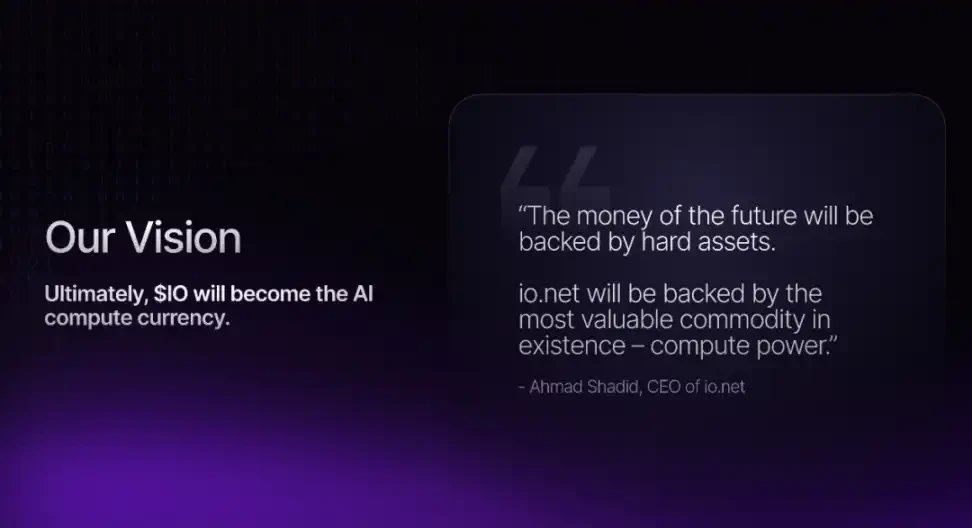
4.1 กรอบงานพื้นฐานของโทเค็น $IO
1. อุปทานคงที่:
อุปทานสูงสุดของโทเค็น $IO ถูกกำหนดไว้ที่ 800 ล้าน อุปทานนี้ถูกกำหนดขึ้นเพื่อให้แน่ใจว่ามูลค่าโทเค็นมีเสถียรภาพและป้องกันภาวะเงินเฟ้อ
2. การจัดจำหน่ายและสิ่งจูงใจ:
ในช่วงแรกจะมีการออกโทเค็น $IO จำนวน 300 ล้านโทเค็น ส่วนที่เหลืออีก 500 ล้านโทเค็นจะออกเพื่อเป็นรางวัลแก่ซัพพลายเออร์และผู้ถือหุ้น ซึ่งคาดว่าจะใช้เวลาถึง 20 ปี รางวัลจะออกทุกชั่วโมงและลดลงตามแบบจำลอง (เริ่มต้นที่ 8% ในปีแรก ลดลง 1.02% ต่อเดือน หรือประมาณ 12% ต่อปี) จนกว่าจะถึงขีดจำกัดการออกโทเค็นทั้งหมด 800 ล้านโทเค็น
3.กลไกการทำลาย:
$IO ใช้ระบบทำลายโทเค็นแบบโปรแกรม ซึ่งใช้รายได้ที่สร้างโดย io.net จากเครือข่าย IOG เพื่อซื้อและทำลายโทเค็น $IO กลไกการทำลายจะปรับปริมาณการทำลายตามราคาของ $IO เพื่อสร้างแรงกดดันด้านภาวะเงินฝืดให้กับโทเค็น
4.2 ต้นทุนและผลประโยชน์
ค่าธรรมเนียมการใช้งาน:
io.net เรียกเก็บค่าธรรมเนียมต่างๆ จากผู้ใช้และผู้ให้บริการ รวมถึงค่าธรรมเนียมการจองและค่าธรรมเนียมการชำระเงินเมื่อทำการจองพลังการประมวลผล ค่าธรรมเนียมเหล่านี้กำหนดขึ้นเพื่อรักษาความแข็งแกร่งทางการเงินของเครือข่ายและสนับสนุนการหมุนเวียนในตลาดของ $IO
การชำระค่าธรรมเนียม:
สำหรับการชำระเงินด้วย USDC จะมีการเรียกเก็บค่าธรรมเนียม 2% ส่วนการชำระเงินด้วย $IO ไม่มีการเรียกเก็บค่าธรรมเนียม
ค่าธรรมเนียมซัพพลายเออร์:
เช่นเดียวกับผู้ใช้ ซัพพลายเออร์จะต้องชำระค่าธรรมเนียมที่สอดคล้องกันเมื่อได้รับการชำระเงิน รวมถึงค่าธรรมเนียมการจองและค่าธรรมเนียมการชำระเงิน
4.3 ระบบนิเวศ
ผู้เช่า GPU (หรือที่เรียกว่าผู้ใช้) เช่น วิศวกรการเรียนรู้ของเครื่องจักรที่ต้องการซื้อพลังการประมวลผล GPU บนเครือข่าย IOG วิศวกรเหล่านี้สามารถใช้ $IO เพื่อปรับใช้คลัสเตอร์ GPU อินสแตนซ์เกมบนคลาวด์ และสร้างแอปพลิเคชันสตรีมมิ่งพิกเซล Unreal Engine 5 (และที่คล้ายกัน) ผู้ใช้ยังรวมถึงผู้บริโภครายบุคคลที่ต้องการดำเนินการอนุมานโมเดลแบบไม่มีเซิร์ฟเวอร์บน BC 8.ai และแอปพลิเคชันและโมเดลอีกหลายร้อยรายการที่ io.net จะโฮสต์ในอนาคต เจ้าของ GPU (หรือที่เรียกว่าซัพพลายเออร์) เช่น ศูนย์ข้อมูลอิสระ ฟาร์มขุดคริปโต และนักขุดมืออาชีพ ต้องการให้พลังการประมวลผล GPU ที่ไม่ได้ใช้ประโยชน์อย่างเต็มที่บนเครือข่าย IOG และสร้างผลกำไรจากมัน ผู้ถือเหรียญ IO (หรือที่เรียกว่าชุมชน) มีส่วนร่วมในการให้ความปลอดภัยทางเศรษฐกิจคริปโตและแรงจูงใจเพื่อประสานผลประโยชน์ร่วมกันและบทลงโทษระหว่างฝ่ายต่างๆ เพื่อส่งเสริมการพัฒนาและการนำเครือข่ายไปใช้
4.4 การจัดสรรอย่างเฉพาะเจาะจง
ชุมชน: 50% ของการจัดสรรทั้งหมด ส่วนโทเค็นนี้ใช้เป็นหลักเพื่อตอบแทนสมาชิกชุมชนและกระตุ้นให้แพลตฟอร์มมีส่วนร่วมและเติบโต ระบบนิเวศ RD: 16% เพื่อสนับสนุนกิจกรรม RD ของแพลตฟอร์มและการสร้างระบบนิเวศ รวมถึงพันธมิตรและนักพัฒนาบุคคลที่สาม ผู้สนับสนุนหลักเริ่มต้น: 11.3% เพื่อตอบแทนสมาชิกในทีมที่ให้การสนับสนุนสำคัญในช่วงเริ่มต้นของแพลตฟอร์ม ผู้สนับสนุนรายแรก: เมล็ดพันธุ์: 12.5% เพื่อตอบแทนนักลงทุนเมล็ดพันธุ์ในช่วงเริ่มต้นสำหรับความไว้วางใจและการสนับสนุนทางการเงินในช่วงเริ่มต้นของโครงการ ผู้สนับสนุนรายแรก: ซีรี่ส์ A: 10.2% ให้กับนักลงทุนซีรี่ส์ A เพื่อตอบแทนการลงทุนเงินและทรัพยากรของพวกเขาในช่วงเริ่มต้นของการพัฒนาโครงการ
4.5 กลไกการแบ่งครึ่ง
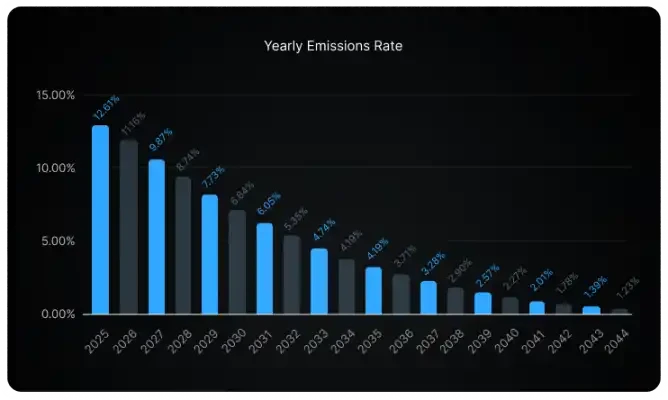
2024-2025: ในช่วง 2 ปีดังกล่าว จะมีการปล่อยโทเค็น $IO จำนวน 6,000,000 โทเค็นต่อปี 2026-2027: เริ่มตั้งแต่ปี 2026 เป็นต้นไป จำนวนเงินที่ปล่อยในแต่ละปีจะลดลงเหลือครึ่งหนึ่งเป็น 3,000,000 โทเค็น $IO 2028-2029: จำนวนเงินที่ปล่อยจะยังคงลดลงเหลือครึ่งหนึ่งเป็น 1,500,000 โทเค็น $IO ต่อปี
5. ทีมงาน/ความร่วมมือ/การจัดหาเงินทุน

io.net มีทีมผู้นำที่มีทักษะและประสบการณ์หลากหลาย โดยมีประสบการณ์หลายทศวรรษในภาคเทคโนโลยีซึ่งช่วยให้บริษัทประสบความสำเร็จ
Tory Green เป็น COO ของ io.net และก่อนหน้านี้เคยเป็น COO ของ Hum Capital และผู้อำนวยการฝ่ายพัฒนาองค์กรและกลยุทธ์ที่ Fox Mobile Group
Ahmad Shadid เป็นผู้ก่อตั้งและซีอีโอของ io.net และเคยเป็นวิศวกรระบบเชิงปริมาณที่ WhalesTrader
Garrison Yang เป็นประธานเจ้าหน้าที่ฝ่ายกลยุทธ์และประธานเจ้าหน้าที่ฝ่ายการตลาดที่ io.net และก่อนหน้านี้เคยดำรงตำแหน่งรองประธานฝ่ายการเติบโตและกลยุทธ์ที่ Ava Labs เขาสำเร็จการศึกษาจากมหาวิทยาลัยแคลิฟอร์เนีย ซานตาบาร์บารา สาขาวิศวกรรมสุขภาพสิ่งแวดล้อม

ในเดือนมีนาคมของปีนี้ io.net ได้รับเงินทุน Series A จำนวน $30 ล้านเหรียญ ซึ่งนำโดย Hack VC พร้อมทั้งมีส่วนร่วมจาก Multicoin Capital, 6th Man Ventures, M 13, Delphi Digital, Solana Labs, Aptos Labs, Foresight Ventures, Longhash, SevenX, ArkStream, Animoca Brands, Continue Capital, MH Ventures และ OKX รวมทั้งผู้นำในอุตสาหกรรมอย่างผู้ก่อตั้ง Solana อย่าง Anatoly Yakovenk, ผู้ก่อตั้ง Aptos อย่าง Mo Shaikh และ Avery Ching, Yat Siu แห่ง Animoca Brands และ Jin Kang แห่ง Perlone Capital
6. การประเมินโครงการ
6.1 การวิเคราะห์เส้นทาง
io.net เป็นเครือข่ายคอมพิวเตอร์แบบกระจายอำนาจที่ใช้บล็อคเชน Solana โดยมุ่งเน้นที่การให้พลังการประมวลผลอันทรงพลังด้วยการผสานทรัพยากร GPU ที่ไม่ได้ใช้งานอย่างเต็มที่ โปรเจ็กต์นี้ส่วนใหญ่อยู่ในพื้นที่การติดตามต่อไปนี้:
1. การประมวลผลแบบกระจายอำนาจ
io.net ได้สร้างเครือข่ายโครงสร้างพื้นฐานทางกายภาพแบบกระจายอำนาจ (Depin) ที่ใช้ทรัพยากร GPU จากแหล่งต่างๆ (เช่น ศูนย์ข้อมูลอิสระ ผู้ขุดคริปโต) แนวทางแบบกระจายอำนาจนี้มุ่งหวังที่จะเพิ่มประสิทธิภาพการใช้ทรัพยากรคอมพิวเตอร์และลดต้นทุนพร้อมทั้งเพิ่มการเข้าถึงและความยืดหยุ่น
2. การประมวลผลบนคลาวด์
แม้จะมีแนวทางแบบกระจายอำนาจ แต่ io.net ก็ให้บริการที่คล้ายกับระบบคลาวด์คอมพิวติ้งแบบเดิม เช่น การจัดการคลัสเตอร์ GPU และความสามารถในการปรับขนาดสำหรับงานการเรียนรู้ของเครื่อง io.net มีเป้าหมายที่จะสร้างประสบการณ์ที่คล้ายกับบริการคลาวด์แบบเดิม แต่ใช้ประโยชน์จากข้อดีของเครือข่ายแบบกระจายอำนาจเพื่อมอบโซลูชันที่มีประสิทธิภาพและคุ้มต้นทุนมากขึ้น
3. แอปพลิเคชั่นบล็อคเชน
เนื่องจากเป็นโครงการที่ใช้เทคโนโลยีบล็อคเชน io.net จึงใช้คุณลักษณะของบล็อคเชน เช่น ความปลอดภัยและความโปร่งใสในการจัดการทรัพยากรและธุรกรรมในเครือข่าย
โครงการที่มีฟังก์ชันการทำงานและเป้าหมายคล้ายกับ io.net ประกอบด้วย:
Golem: เป็นเครือข่ายคอมพิวเตอร์แบบกระจายอำนาจที่ผู้ใช้สามารถเช่าหรือให้เช่าทรัพยากรคอมพิวเตอร์ที่ไม่ได้ใช้ Golem มุ่งมั่นที่จะสร้างซูเปอร์คอมพิวเตอร์ระดับโลก Render: ใช้เครือข่ายแบบกระจายอำนาจเพื่อให้บริการการเรนเดอร์กราฟิก Render ใช้เทคโนโลยีบล็อคเชนเพื่อให้ผู้สร้างเนื้อหาสามารถเข้าถึงทรัพยากร GPU ได้มากขึ้น จึงทำให้กระบวนการเรนเดอร์เร็วขึ้น iExec RLC: โปรเจ็กต์นี้สร้างตลาดแบบกระจายอำนาจที่ให้ผู้ใช้สามารถเช่าทรัพยากรคอมพิวเตอร์ของตนได้ iExec รองรับแอปพลิเคชันประเภทต่างๆ ผ่านเทคโนโลยีบล็อคเชน รวมถึงแอปพลิเคชันที่ใช้ข้อมูลจำนวนมากและเวิร์กโหลดการเรียนรู้ของเครื่อง
6.2 ข้อดีของโครงการ
ความสามารถในการปรับขนาด: io.net ได้ออกแบบแพลตฟอร์มที่ปรับขนาดได้สูงโดยเฉพาะเพื่อตอบสนองความต้องการแบนด์วิดท์ของลูกค้าและช่วยให้ทีมงานปรับขนาดเวิร์กโหลดบนเครือข่าย GPU ได้อย่างง่ายดายโดยไม่ต้องปรับเปลี่ยนขนาดใหญ่ การอนุมานแบบแบตช์และการให้บริการโมเดล: แพลตฟอร์มรองรับการอนุมานแบบขนานบนแบตช์ข้อมูล ช่วยให้ทีมงานการเรียนรู้ของเครื่องสามารถปรับใช้เวิร์กโฟลว์บนเครือข่าย GPU แบบกระจายได้
การฝึกแบบคู่ขนาน: เพื่อเอาชนะข้อจำกัดของหน่วยความจำและเวิร์กโฟลว์แบบต่อเนื่อง io.net ใช้ประโยชน์จากไลบรารีการคำนวณแบบกระจายเพื่อทำงานการฝึกแบบคู่ขนานบนอุปกรณ์หลายเครื่อง การปรับไฮเปอร์พารามิเตอร์แบบคู่ขนาน: io.net ใช้ประโยชน์จากความขนานโดยธรรมชาติของการทดลองปรับไฮเปอร์พารามิเตอร์เพื่อปรับตารางเวลาและรูปแบบการค้นหาให้เหมาะสม การเรียนรู้แบบเสริมแรง (RL): io.net รองรับเวิร์กโหลด RL แบบกระจายสูงโดยใช้ไลบรารีการเรียนรู้แบบโอเพ่นซอร์ส และจัดเตรียม API ที่เรียบง่าย
การเข้าถึงได้ทันที: แตกต่างจากการปรับใช้ระบบคลาวด์แบบเดิมในระยะยาว io.net Cloud ให้การเข้าถึงการจัดเตรียม GPU ได้ทันที ช่วยให้ผู้ใช้สามารถเปิดโปรเจ็กต์ของตนได้ภายในไม่กี่วินาที
ประสิทธิภาพด้านต้นทุน: io.net ได้รับการออกแบบมาให้เป็นแพลตฟอร์มราคาไม่แพงที่เหมาะกับผู้ใช้หลากหลายประเภท ปัจจุบัน แพลตฟอร์มนี้มีประสิทธิภาพด้านต้นทุนมากกว่าบริการคู่แข่งประมาณ 90% ซึ่งช่วยประหยัดค่าใช้จ่ายได้อย่างมากสำหรับโครงการการเรียนรู้ของเครื่อง
ความปลอดภัยและความน่าเชื่อถือสูง: แพลตฟอร์มนี้สัญญาว่าจะมอบความปลอดภัย ความน่าเชื่อถือ และการสนับสนุนทางเทคนิคระดับชั้นนำเพื่อให้แน่ใจว่าสภาพแวดล้อมที่ปลอดภัยและมีเสถียรภาพสำหรับงานการเรียนรู้ของเครื่องจักร ความสะดวกในการใช้งาน: io.net Cloud ขจัดความซับซ้อนในการสร้างและจัดการโครงสร้างพื้นฐาน ทำให้ผู้พัฒนาและองค์กรต่างๆ สามารถพัฒนาและปรับขนาดแอปพลิเคชัน AI ได้อย่างราบรื่น
6.3 ความท้าทายของโครงการ
1. ความซับซ้อนทางเทคนิคและการยอมรับของผู้ใช้
ความท้าทาย: แม้ว่าการประมวลผลแบบกระจายอำนาจจะมีข้อได้เปรียบด้านต้นทุนและประสิทธิภาพอย่างมาก แต่ความซับซ้อนของเทคโนโลยีอาจเป็นอุปสรรคสำคัญต่อการเข้าถึงสำหรับผู้ใช้ที่ไม่มีความรู้ด้านเทคนิค ผู้ใช้จำเป็นต้องเข้าใจวิธีการใช้งานเครือข่ายแบบกระจายอำนาจและวิธีใช้ทรัพยากรแบบกระจายอำนาจอย่างมีประสิทธิภาพ ผลกระทบ: ซึ่งอาจจำกัดการนำแพลตฟอร์มมาใช้อย่างแพร่หลาย โดยเฉพาะในกลุ่มผู้ใช้ที่ไม่คุ้นเคยกับบล็อคเชนและการประมวลผลแบบกระจายอำนาจมากนัก
2. ความปลอดภัยทางไซเบอร์และความเป็นส่วนตัวของข้อมูล
ความท้าทาย: แม้ว่าบล็อคเชนจะช่วยเพิ่มความปลอดภัยและความโปร่งใส แต่ความเปิดกว้างของเครือข่ายแบบกระจายอำนาจอาจทำให้เครือข่ายเสี่ยงต่อการโจมตีทางไซเบอร์และการละเมิดข้อมูลมากขึ้น ผลกระทบ: จำเป็นต้องให้ io.net เสริมมาตรการรักษาความปลอดภัยอย่างต่อเนื่องเพื่อให้แน่ใจว่าข้อมูลผู้ใช้และงานคอมพิวเตอร์มีความลับและสมบูรณ์ ซึ่งถือเป็นกุญแจสำคัญในการรักษาความไว้วางใจของผู้ใช้และชื่อเสียงของแพลตฟอร์ม
3. ประสิทธิภาพและความน่าเชื่อถือ
ความท้าทาย: แม้ว่า io.net จะพยายามให้บริการคอมพิวเตอร์ที่มีประสิทธิภาพผ่านทรัพยากรแบบกระจายอำนาจ แต่การประสานงานระหว่างทรัพยากรฮาร์ดแวร์จากสถานที่ตั้งทางภูมิศาสตร์ที่แตกต่างกันและคุณภาพที่แตกต่างกันอาจนำมาซึ่งความท้าทายในด้านประสิทธิภาพและความน่าเชื่อถือ ผลกระทบ: ปัญหาประสิทธิภาพใดๆ ที่เกิดจากความไม่ตรงกันของฮาร์ดแวร์หรือความล่าช้าของเครือข่ายอาจส่งผลต่อความพึงพอใจของลูกค้าและประสิทธิภาพโดยรวมของแพลตฟอร์ม
4. ความสามารถในการปรับขนาด
ความท้าทาย: แม้ว่า io.net จะได้รับการออกแบบมาให้เป็นเครือข่ายที่มีความสามารถในการปรับขนาดได้สูง แต่การจัดการและปรับขนาดทรัพยากรที่กระจายอยู่ทั่วโลกอย่างมีประสิทธิภาพก็ยังถือเป็นความท้าทายทางเทคนิคที่ยิ่งใหญ่ ผลกระทบ: จำเป็นต้องมีนวัตกรรมทางเทคนิคและการปรับปรุงการจัดการอย่างต่อเนื่องเพื่อให้เครือข่ายมีเสถียรภาพและตอบสนองได้ทันต่อความต้องการของผู้ใช้และการประมวลผลที่เพิ่มขึ้นอย่างรวดเร็ว
5. การแข่งขันและการยอมรับของตลาด
ความท้าทาย: io.net ไม่ใช่ไม่มีการแข่งขันในตลาดบล็อคเชนและคอมพิวเตอร์แบบกระจายอำนาจ แพลตฟอร์มอื่นๆ เช่น Golem, Render และ iExec ก็ให้บริการที่คล้ายคลึงกันเช่นกัน และการเปลี่ยนแปลงอย่างรวดเร็วในตลาดอาจเปลี่ยนสถานการณ์การแข่งขันได้อย่างรวดเร็ว ผลกระทบ: เพื่อที่จะคงความสามารถในการแข่งขันไว้ได้ io.net ต้องสร้างสรรค์นวัตกรรมและปรับปรุงเอกลักษณ์และคุณค่าของบริการอย่างต่อเนื่องเพื่อดึงดูดและรักษาผู้ใช้เอาไว้
7. บทสรุป
โดยสรุป io.net ได้สร้างมาตรฐานใหม่ในด้านการประมวลผลบนคลาวด์ที่ทันสมัยด้วยเครือข่ายการประมวลผลแบบกระจายอำนาจที่สร้างสรรค์และสถาปัตยกรรมแบบบล็อคเชน ด้วยการรวมทรัพยากร GPU ที่ไม่ได้ใช้ประโยชน์อย่างเต็มที่จากทั่วโลก io.net จึงมอบพลังการประมวลผล ความยืดหยุ่น และความคุ้มทุนที่ไม่เคยมีมาก่อนสำหรับแอปพลิเคชันการเรียนรู้ของเครื่องจักรและปัญญาประดิษฐ์ แพลตฟอร์มนี้ไม่เพียงแต่ทำให้การปรับใช้โปรเจ็กต์การเรียนรู้ของเครื่องจักรขนาดใหญ่รวดเร็วและประหยัดมากขึ้นเท่านั้น แต่ยังมอบความปลอดภัยที่แข็งแกร่งและโซลูชันที่ปรับขนาดได้สำหรับผู้ใช้ทุกประเภทอีกด้วย
เมื่อเผชิญกับความท้าทายต่างๆ เช่น ความซับซ้อนทางเทคนิค ความปลอดภัยของเครือข่าย ความเสถียรของประสิทธิภาพ และการแข่งขันในตลาด หาก IO.Net สามารถเอาชนะความท้าทายและสร้างระบบนิเวศที่มีชีวิตชีวาได้ ก็จะมีศักยภาพที่จะปรับเปลี่ยนวิธีการเข้าถึงและใช้งานพลังการประมวลผลในยุค Web3 ได้อย่างพื้นฐาน อย่างไรก็ตาม เช่นเดียวกับเทคโนโลยีใหม่ใดๆ ก็ตาม สิ่งสำคัญคือต้องตระหนักว่าความสำเร็จในระยะยาวนั้นจะขึ้นอยู่กับการพัฒนาอย่างต่อเนื่อง การนำไปใช้ และความสามารถในการนำทางในภูมิทัศน์ที่เปลี่ยนแปลงไปของโครงสร้างพื้นฐานที่ใช้บล็อคเชน
บทความนี้มีที่มาจากอินเทอร์เน็ต: คำอธิบายโดยละเอียดของโครงการ io.net ล่าสุดของ Binance Launchpool: การเชื่อมต่อทรัพยากร GPU ทั่วโลกเพื่อปรับเปลี่ยนอนาคตของการเรียนรู้ของเครื่องจักร
ที่เกี่ยวข้อง: GameCene ผู้บุกเบิกในการสร้างระบบนิเวศการเล่นเกม Web3 ได้รับเงินทุนสนับสนุน $1.4 ล้าน
GameCene ซึ่งเป็นแพลตฟอร์มเผยแพร่เกม Web3 ได้ประกาศความสำเร็จของการระดมทุนรอบ Seed โดยระดมทุนได้ $1.4 ล้าน เงินทุนนี้จะกระตุ้นการเติบโตของ GameCene เร่งการพัฒนาแพลตฟอร์ม ขยายคลังเกมที่หลากหลาย และปรับปรุงการจัดการและการสร้างรายได้จากสินทรัพย์ของผู้ใช้ GameCene: ตัวเร่งสำหรับการปฏิวัติการเล่นเกม Web3 ภารกิจของ GameCene คือการเชื่อมช่องว่างระหว่างนักพัฒนา Web2 และผู้เล่น ทำให้พวกเขาสามารถเปลี่ยนเข้าสู่โลกแห่งเกม Web3 ได้อย่างราบรื่น แพลตฟอร์มดังกล่าวนำเสนอระบบนิเวศการเล่นเกมแบบใหม่สำหรับผู้เล่น มอบประสบการณ์ความบันเทิงที่ไม่เหมือนใครและเพิ่มศักยภาพในการสร้างรายได้อย่างมีประสิทธิภาพของสินทรัพย์ในเกมผ่านเทคโนโลยี Web3 Omni-chain Game SDK: เพิ่มศักยภาพให้กับนักพัฒนาเกม Omni-chain Game SDK ของ GameCene ช่วยให้นักพัฒนาหลายล้านคนสามารถสร้างและแจกจ่ายเกมบล็อกเชนได้อย่างง่ายดาย SDK มีชุดเครื่องมือที่ครอบคลุม...





